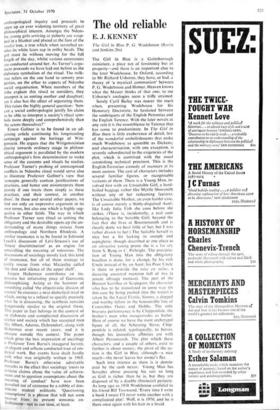The old reliable
E. J. KENNEY
The Girl in Blue P. G. Wodehouse (Barrie and Jenkins 26s)
The Girl in Blue is a Gainsborough miniature, a piece not of femininity but of property—and there is an important clue to the later Wodehouse. In Oxford, according to Mr Richard Usborne, they have, or had, a theory of 'a mystical communion' between P. G. Wodehouse and Homer. Heaven knows what the Master thinks of that one; to me Usborne's analogies seem a trifle strained.
Surely Cyril Bailey was nearer the mark when, presenting Wodehouse for his Honorary Doctorate, he hesitated between the soubriquets of the English Petronius and the English Terence. With the later novels at any rate it is the resemblance to Terence that has come to predominate. In The Girl in Blue there is little exuberance of detail, few of the wonderful embellishments that make much Wodehouse as quotable as Dickens; and characterisation, with one exception, is severely subordinated to the exigencies of the plot, which is contrived with the usual astonishing technical precision. This is the English-Terentian comedy of manners at its most austere. The cast of characters includes several familiar figures, or recognisable variants of them. There is a Young Man, in- volved first with an Unsuitable Girl, a hard- boiled baggage rather like Myrtle Shoesmith without any of her redeeming features. The Unsuitable Mother, an even harder case, is of course merely a thinly-disguised Aunt; like Lady Julia Fish she coos before she strikes. (There is, incidentally, a real aunt belonging to the Suitable Girl; beyond the fact that she lives at Bournemouth and is clearly dotty we hear little of her, but I was rather drawn to her.) The Suitable herself is nice but a bit lacking in oomph and espieglerie; though described at one place as an attractive young prune she is a far cry from S. Byng or C. Pirbright. The precipita- tion of Young Man into the obligatory bouillon is done, for a change, by his rich Uncle instead of by an Aunt; his Poor Uncle is there to provide the mice en scene, a decaying ancestral mansion full of PGs (a potent offstage menace). The part of the Human Sacrifice or Scapegoat, the character who has to be immolated in some way (in this case by being pushed into the'water) is taken by the Local Flattie, Simms, a dogged and worthy fellow in the honourable line of Constables Oates and Dobbs. The only bravura performance is by Chippendale, the broker's man who masquerades as butler. Here of course we have the most archetypal figure of all, the Scheming Slave; Chip- pendale is related, typologically, to Jeeves, though his immediate affinities are with Albert Peasemarch. The plot which these characters, and a couple of others, exist to further is about money; the pivot of the ac- tion is the Girl in Blue, although—a nice touch—she never leaves her owner's flat.
Such love interest as there is is domin- ated by the cash nexus: Young Man has Scruples about pressing his suit so long as Girl is richer than he is, but they are disposed of by a double (financial) peripety. As long ago as 1938 Wodehouse confided to his friend Bill Townsend, 'Every time I write a book I swear I'll never write another with a complicated plot'. Well, it is 1970, and he is 'there once again with his hair in a braid.










































 Previous page
Previous page